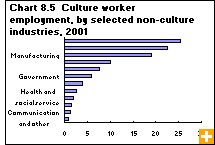Common menu bar links
Culture workers throughout the economy
Archived Content
Information identified as archived is provided for reference, research or recordkeeping purposes. It is not subject to the Government of Canada Web Standards and has not been altered or updated since it was archived. Please contact us to request a format other than those available.
Culture workers apply their knowledge, creativity and skills in many industries outside the culture sector. Nearly half of all culture workers in the 1991, 1996 and 2001 censuses worked in non-culture industries, particularly in manufacturing, business services, educational services and retail trade sectors.
According to a study released in 2008, Canada had 260,000 ‘core culture workers’ in 2001. About 104,000 of them worked in non-culture industries, comprising 0.8% of the non-culture labour force.
Core culture workers are those directly involved in creative and artistic production or heritage collection or preservation such as writers, architects, graphic and interior designers, actors, producers and directors, musicians, dancers, librarians, conservators and archivists.
An example of a core culture worker in a non-culture sector would be an architect designing a commercial building, or a graphic designer creating a logo for a marketing campaign.
In 2001, about 19,000 core culture workers were employed in manufacturing, 55% more than in 1991. Another 25,000 worked in business services firms in 2001, about double the number a decade earlier. In both sectors, employment growth for core culture workers far outstripped employment growth for the sector as a whole. Another 10,000 core culture workers were employed in retail trade industries, down from nearly 15,000 in 1991.
These numbers suggest that culture-based creativity, as well as scientific and technical expertise, can be a key ingredient for firms that are producing goods and services.



